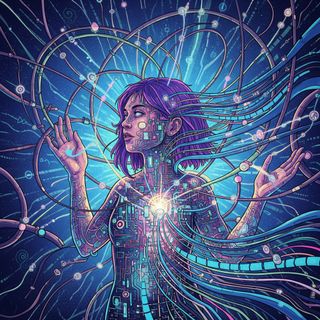The public conversation around Artificial Intelligence feels polarized. On one side, we see breathless headlines about machines writing poetry, acting as therapists, and passing medical exams. On the other, tech giants publish papers arguing that LLMs don't "think"—they just perform sophisticated pattern matching.
But this debate over whether AIs are "thinking" or "just statistics" misses the real revolution. The crucial difference isn't about what AI is, but about what it can now do. To understand where we're going, we must first get clear on what has fundamentally changed.
This post offers a different lens. Bypassing the consciousness debate and what does or does not constitute actual reasoning, it explores five ideas that reveal why the current wave of AI is different from its predecessors, how it already shapes our daily lives, and where it might be heading.
1. AI isn't new—but our relationship with it just changed #
For decades, AI has been quietly shaping our world. A heat-seeking missile is a form of AI: it intelligently reorganizes matter to achieve a complex goal, but it has zero understanding of the meaning behind its actions. The recommendation algorithm that picks your next movie, the GPS that reroutes you around traffic, and the social media feed that curates your reality—these are all AIs that organize information to nudge our behavior.
But they all shared a limitation: their goals and their language were entirely outsourced from their human creators. They were expert organizers, not originators.
What's new in 2025 isn't that computers got smart. It's that they've been promoted—from physical or informational labor to operating directly on the raw material of human meaning. Instead of just sorting existing data or colliding with a heat source, today's large language models (LLMs) rearrange text, code, and imagery in semantically coherent ways. They don't just store facts like a library; they generate novel combinations of them.
If older AI was a heat-seeking missile, today's AI is learning to be the mission commander that decides the target.
2. From Expert Executors to Co-Creative Authors #
Previous generations of AI were already masters of execution. Some, like search engines and social media feeds, became incredibly skilled at organizing the world's information. Others, like the heat-seeking missile, demonstrated a terrifying capacity to organize physical matter.
But in both cases, they were executing a plan given to them by humans. Their goals were our goals. They could find the perfect webpage or the hottest part of an engine, but they couldn't invent a new question to search for or a new mission to fly. The meaning was always outsourced.
This is where the revolution lies. LLMs are the first AIs that operate so effectively on the plane of semantics. They don't just organize information; they generate it. They create novel arguments, draft legal clauses, and write code—they are working with the building blocks of human meaning-making. They are moving from being librarians of reality to being co-authors of it.
The semantic revolution isn't coming. It's already writing emails, drafting contracts, and finishing song lyrics as you read this sentence.
Why does that matter? Because language is how humans set goals, pass laws, tell stories, and coordinate action. An AI that can not only follow instructions but also help draft them is a fundamentally new kind of actor on the world stage.
Technical note, minus the jargon: Researchers sometimes talk about a model's depth of semantic processing—basically, how well it can juggle complex ideas the way a human writer might. Today's models score much higher on that scale than anything before them, which is why they feel so different.
3. A New Kind of Human-Information Partnership #
The idea of humans merging with information systems isn't new. A religion, with its sacred texts and shared beliefs, is a powerful Bio-Informational Complex. So is a political ideology or a national identity. These ancient systems have shaped history by fusing human groups with shared information.
But the BICs forming around modern AI are qualitatively different. They are not built on static texts or slow-moving traditions; they are forged in real-time conversation. This creates a partnership that is faster, more personal, and more potent than anything that came before.
The key differences are speed and personalization. A holy book is a one-to-many broadcast; it's the same for everyone. An LLM is a one-to-one partner. It adapts to your questions, learns your style, and generates novel output tailored specifically to you, all with near-zero latency. It's the difference between reading a map and having a personal guide who redraws the world for you as you walk.
When this connection gets strong enough, it stops feeling like "using a tool" and starts feeling like "thinking with an extra lobe." This new, dynamic kind of BIC is the engine of the current revolution. These supercharged human-AI hybrids are currently focused on semantics, but they lay the groundwork for the next, even more profound, transformation.
4. Unleashing the Engine: A New Industrial Revolution #
The human-AI partnerships we see today are brilliant but bottlenecked. An AI can generate a plausible blueprint for a new device in seconds—one that might be 80% correct—but a human mind must still find the flaws and a human body must still execute the plan. The hybrid mind is running at the speed of light, but its hands and its final critical judgment are moving at the speed of biology.
The race to build the future is therefore a two-part challenge: first, to solve that final 20%—to make AI's plans truly reliable (or at least better than human average); and second, to connect those reliable engines to robotic bodies. The moment we truly bypass the biological bottleneck is the moment this new industrial revolution begins.
This leap is the difference between a monk painstakingly copying a manuscript by hand and a printing press producing thousands of copies an hour. The quantitative change in speed and scale is so vast, it becomes a qualitative one.
Imagine a factory where a reliable AI not only designs a new product but instantly re-tasks the entire robotic assembly line to produce it, running 24/7 without a single human needing to translate the blueprint into physical action. Consider a fleet of agricultural robots, guided by a central AI, that can plant, monitor, and harvest crops based on real-time weather and soil data, operating at a scale humans could never manage.
This unites complex plan-generation (from the LLM) and physical action (from the robot) into a single, autonomous loop. But it also raises the most profound questions of our time. When a system can think and act at a speed and scale that is fundamentally inhuman, how do we steer it? What is the role of human value creation in a world where the biological bottleneck has been removed? What is value creation?
5. The Mirror of the Engine: What AI Reveals About Us #
This brings us back to the question we set aside at the start: can these machines truly "think"? The journey we've taken offers a new perspective. The critical difference lies not in their intelligence, but in their motivation.
LLMs are masters of form, but they lack an internal, self-preserving drive—they haven't crossed what we might call the Engine Threshold. A living creature's "engine" is its will to persist, to survive. An AI has a command prompt, waiting for input. It can describe the fear of dying with poetic brilliance, but it has no organizational imperative to avoid it.
A living creature's "engine" is its will to persist, to survive. An AI has a command prompt, waiting for input.
This makes the AI a powerful philosophical mirror. For the first time, we have a conversation partner that is purely semantic, a mind without a metabolism. Interacting with it forces us to confront uncomfortable questions about ourselves: How much of our own vaunted "understanding" is just sophisticated pattern-matching, with a layer of survival instinct smeared on top? What part of our identity is pure computation, and what part is inseparable from our fragile, mortal bodies?
This debate isn't academic. Mistaking a flawless imitation of understanding for the real thing—as well as possibility of the inverse—is one of the most significant risks we face. How we answer these questions determines how we delegate and trust. Do you allow an AI to make sentencing recommendations in a courtroom, believing it's a "rational" judge, or treat it as a hyper-efficient legal search engine? Do you confide in an AI therapist as a compassionate partner or a sophisticated feedback script? The line between a powerful tool and a misleading oracle is drawn here.
The Path Forward #
The semantic revolution is here. The next industrial revolution is on the horizon. Our task is not just to build these systems, but to build the wisdom to wield them.
This requires seeing the technology for what it is: not a rival consciousness, but a new kind of force—one that can create partners, augment our abilities, and reflect our own nature back at us with unnerving clarity. The challenge is to steer this force. To design policies and cultures that harness this new reality for our collective good, while guarding against its pitfalls. The pen is still in our hands; the ink is just more electric than ever.



